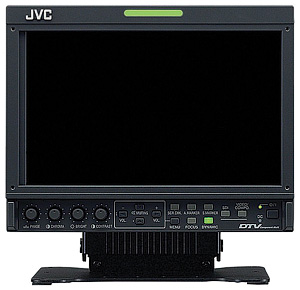JVC DT-V9L1DU Portable HD Monitor
The JVC DT-V9L1DU is a portable 9-inch LCD monitor ideally suited for HD monitoring in the field. This is the smallest of JVC's series of monitors that range from nine to 24 diagonal inches. The advantage of the 9-inch DT-V9L1DU is that it offers portability without sacrificing reliable image quality. It accepts HD/SD SDI, component or composite inputs and can run on AC or from battery power.
FEATURES
The JVC DT-V9L1DU monitor features a 16:9 high-resolution LCD display designed for portability and ease of use. It is housed in a rugged metal case with a carrying handle and weighs a mere 6 pounds without the stand.
To make it truly field worthy, the JVC DT-V9L1DU can run on 12–17 V batteries such as the Anton/Bauer DIONIC90 or the IDX ENDURA-75, either of which can be mounted on the rear of the monitor. The LCD panel is protected by a screen protection filter and a moveable stand can be attached to provide better viewing angles.

The JVC DT-V9L1DU 9-inch Portable HD LCD Monitor Despite its size, the JVC DT-V9L1DU maintains high performance specs. Its 8-bit processor is designed to produce clear images whether the content is slow or fast and to eliminate jagged lines and block noise. Screen resolution is 800x480 with 16.2 million colors and a 400:1 contrast ratio.
The rear panel has inputs for HD/SD SDI, analog component and composite video. An RCA in and out jack is provided for analog sound monitoring. The monitor can also be controlled through a PC using the RS-232C interface or a "MAKE/TRIGGER" system.
The front panel maintains a familiar and simple set of controls that are not overly reliant on a menu. Physical rotating knobs control phase, chroma, brightness, and contrast. Input is selected by pressing one of two buttons: SDI or Video/Component. The selected button glows green so you always know which input is active. Audio volume controls are simple buttons that activate an on-screen indicator displaying the volume setting.
Up to 12 audio channels can be imbedded in a digital video signal. You can select which channels you wish to monitor on the screen by adjusting the settings in the menu. This allows you to monitor both picture quality and audio levels on the same display.
The JVC DT-V9L1DU is a fully professional monitor and includes "screen check" controls for correct calibration. Pressing the "screen check" button changes the screen from normal to monochrome, red, green or blue. The familiar blue screen enables you to calibrate the monitor to SMPTE color bars.
IN USE
This JVC monitor is designed in the tradition of its analog ancestors and is intuitively easy to use. I found I didn't need to read the manual, which I view as a test of user friendliness.
I first tested it as an HD deck monitor by connecting a Panasonic AJ-HD1400 DVCPRO HD deck to the JVC DT-V9L1DU monitor via the SDI connection. Then I selected the SDI input button on the monitor, rolled an HD tape and witnessed crisp and clear image monitoring. It was that simple. The tape in the deck was shot in the 720p/59.94 format and the monitor correctly displayed this information for several seconds after the tape was rolling. The displayed image was sharp with very true color reproduction. The image was reliably accurate, with no degradation or signs of overprocessing.
For my next test, I wanted to see how the JVC DT-V9L1DU monitor would perform—as I would like to use it—as a camera field monitor.
I then connected the monitor to a Panasonic AG-HVX200 DVCPRO HD video camera. The HVX200 does not have an SDI output, but it does come with a cable that provides analog RCA component outputs. I fitted the cable with adapters and plugged the three cables into the corresponding BNC component inputs on the monitor.
Then I selected the "Video/Compo" input. I switched on the camera and was a bit perplexed when I didn't see an image on the monitor. But I stubbornly refused to refer to the manual as this was a field test, and who takes a manual into the field? Nonetheless, I found the solution easily by trial and error. I ventured into the menu and noticed that there is a "Video/Compo" select. I inferred that "Video" stands for composite and "Compo" for component. After selecting "Compo," the image from the camera appeared instantly on the monitor. Here I discovered that the Video/Component button has to be manually set when connecting a composite or component analog signal.
Fast Facts
Application
Field monitoring of HD video.
Key Features
Can be powered from AC or DC sources; monitors embedded audio.
Price
MSRP $2,450
Contact
JVC Professional Products Co.
800-582-5825
www.jvc.com/prof
JVC's DT-V9L1DU monitor provides a couple of features that add to its effectiveness as a field monitor. One is a simple button labeled "DYNAMIC." Pressing this button significantly brightens the image to make it more visible in outdoor conditions. You can also achieve similar results in the menu by increasing the "backlight" setting. However the "DYNAMIC" button offers more brightness and is faster to access. There's also a "FOCUS" button, which greatly increases the detail level of the image. This is actually a very effective way to enable you to achieve better focus from the camera.
As a field monitor, the JVC DT-V9L1DU passed with flying colors. It's an enormous improvement over trying to monitor the camera image through a built-in LCD screen. You can accurately calibrate it to the camera's color bars, and the added image enhancement features make the monitor effective in both indoor and outdoor shooting conditions.
The JVC DT-V9L1DU monitor performed well in all of my tests. I have only one recommendation for improvement. The labeling for the buttons and knobs on the front panel is a pale grey against a dark grey background. As such, the lettering is difficult to read. A bright white or vibrant color would improve readability and facilitate access to the controls.
SUMMARY
Overall, this monitor provides a crisp image that accurately reproduces color and contrast faithful to the original source signal. It is also more rugged than most field monitors without adding too much weight or bulk. It is constructed in a roadworthy housing that can stand a bit of rough treatment. In terms of image quality, price and durability, this is a monitor everyone should consider when seeking a high performance HD unit that is equally useful in the field or the editing suite.
Get the TV Tech Newsletter
The professional video industry's #1 source for news, trends and product and tech information. Sign up below.
